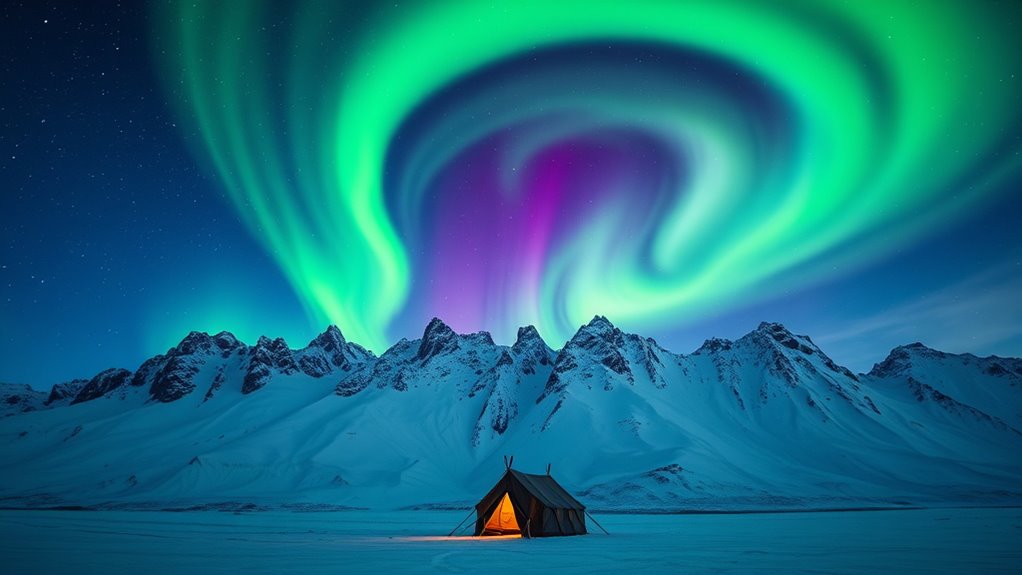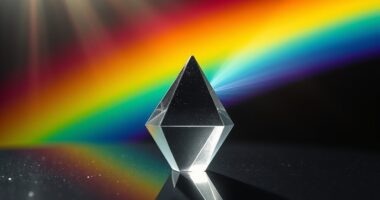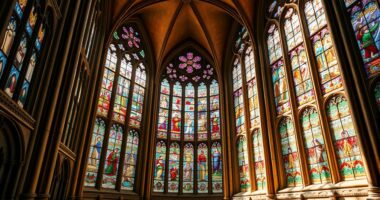The Northern Lights have fascinated humans for centuries, inspiring myths like Valkyries guiding warriors or fox fires in Finnish lore. Scientifically, they occur when solar particles interact with Earth’s magnetic field, creating colorful displays in the sky. These natural phenomena symbolize divine presence and supernatural power across cultures. While science explains how they form, their beauty still sparks awe and wonder. If you keep exploring, you’ll discover even deeper connections between myth and science behind this mesmerizing spectacle.
Key Takeaways
- Many cultures view the aurora as divine messengers, spirits, or signals from gods, inspiring myths and legends.
- Scientific explanations attribute the Northern Lights to charged solar particles colliding with Earth’s magnetic field and atmosphere.
- The colors of the aurora depend on gas types and collision altitudes, with oxygen producing red and green, nitrogen blue and purple.
- Historically, auroras symbolized hope, divine presence, or supernatural power, blending cultural beliefs with natural phenomena.
- Scientific understanding enhances appreciation of auroras while preserving their mythic and cultural significance.

The Northern Lights, also known as the Aurora Borealis, have captivated human imagination for centuries, inspiring myths and legends across cultures. You’ve probably heard stories of spirits dancing in the sky, messengers from the gods, or signals from the afterlife. These stories reflect the deep symbolism people have assigned to the aurora borealis. Many cultures see the lights as symbols of hope, divine presence, or supernatural power. In Norse mythology, they were believed to be the reflections of the armor of Valkyries, warriors who guided fallen soldiers to Valhalla. In Finland, the aurora borealis is called “revontulet,” or fox fires, based on the myth that a fox running across the snow sparks the lights with its tail. These symbols reveal how humans have tried to interpret the mysterious display, attaching meaning to something they couldn’t explain. Additionally, the auroras are a prime example of Earth’s magnetic field interacting with solar particles, showcasing the planet’s natural protective mechanisms. Scientifically, auroras occur when charged particles from the solar wind collide with Earth’s magnetic field. When these particles reach the upper atmosphere near the poles, they excite atoms and molecules, causing them to emit light. This process creates the shimmering curtains of green, pink, purple, and red that dance across the night sky. The scientific explanations of auroras help demystify the phenomenon, showing it as a natural interaction between solar activity and Earth’s magnetic shield. The colors depend on the type of gas involved and the altitude of the collision. For example, oxygen at higher altitudes produces red and green hues, while nitrogen creates blue and purple displays. Understanding these processes allows scientists to predict auroral activity based on solar cycles and space weather. While science provides a clear explanation of how auroras happen, it doesn’t diminish their awe-inspiring beauty or cultural significance. You might stand under a shimmering sky, marveling at the dancing lights, knowing that these spectacular displays are the result of complex natural interactions. Yet, centuries ago, people viewed them as divine or supernatural signs, weaving them into their myths and beliefs. Today, the balance between scientific understanding and myth continues to shape how we see the Northern Lights. They remain a symbol of mystery and wonder, reminding us of nature’s power and beauty. Whether you interpret them as celestial messages or natural phenomena, the aurora borealis continues to inspire awe and curiosity across the world.
Frequently Asked Questions
How Do Different Cultures Interpret the Northern Lights?
You might find that different cultures see the Northern Lights through unique cultural symbolism rooted in their mythological origins. For example, some Indigenous peoples view the lights as spirits dancing in the sky, while Norse legends see them as echoes of battles or Valkyrie armor. These interpretations reflect their beliefs and stories, turning the natural phenomenon into a meaningful part of their cultural identity and mythological understanding.
Can the Northern Lights Be Seen From Space?
You can see the Northern Lights from space, where aurora visibility is spectacular. Space-based observations reveal shimmering curtains of light dancing across Earth’s atmosphere, far beyond what’s visible from the ground. Imagine gazing down from orbit, witnessing the auroras glow vividly against the darkness of space. This perspective offers scientists invaluable insights, confirming that the mesmerizing northern lights are not just a terrestrial wonder but a grand display visible even from space.
What Recent Scientific Discoveries Have Been Made About Auroras?
Recent scientific discoveries reveal that auroras are closely linked to magnetic field interactions and solar activity. Researchers now use advanced aurora forecasting models to predict when these spectacular displays will occur, helping you anticipate viewing opportunities. Scientists also find that variations in Earth’s magnetic field influence aurora intensity and location, deepening our understanding of these natural phenomena. This progress offers exciting insights into space weather effects and how they impact our planet.
Are There Any Health Benefits Associated With Viewing the Northern Lights?
You might find that viewing the northern lights offers some health benefits, like promoting relaxation through aurora meditation, which helps reduce stress. Some people also use light therapy during long winter nights to boost mood and energy levels. Watching the auroras can create a calming experience, encouraging mindfulness. While scientific evidence is limited, incorporating aurora meditation or light therapy while observing the lights could enhance your overall well-being and emotional health.
How Do Climate Change and Solar Activity Affect Auroras?
Climate change and solar activity are like a dance, influencing auroras’ brightness and frequency. You see, increased solar wind from the sun interacts with Earth’s atmospheric composition, creating stunning displays. Climate change can alter atmospheric conditions, sometimes dampening or amplifying auroras. When solar activity peaks, it energizes particles that collide with our atmosphere, making the lights more vivid. So, both factors play a vital role in shaping your northern lights experience.
Conclusion
As you gaze upon the Northern Lights, remember they’re both ancient myth and modern marvel. They dance like celestial flames, whispering stories of our ancestors’ wonder and today’s scientific discovery. Like a bridge between worlds, they remind you that nature’s beauty and mystery are timeless. Embrace their glow, for it’s a shimmering reminder that the universe’s secrets are waiting to be uncovered—hidden in the sky, just beyond your reach, yet forever inspiring your curiosity.









